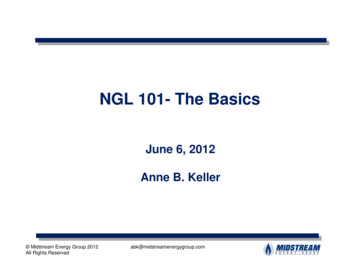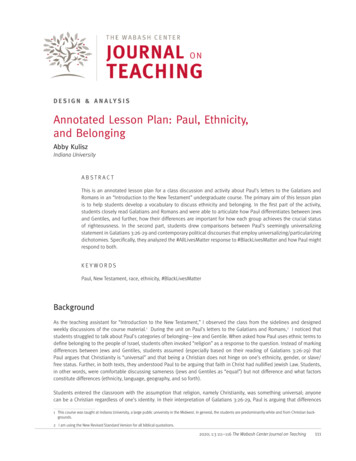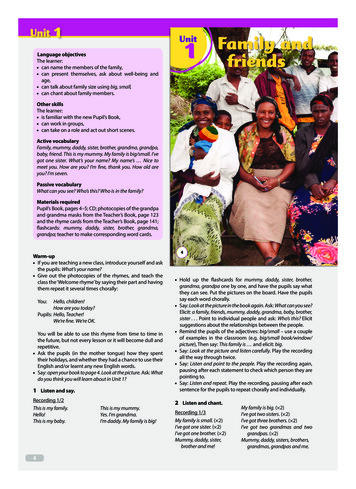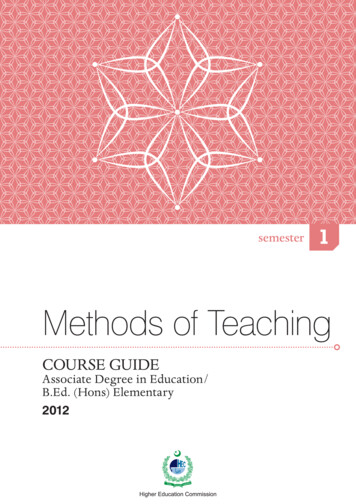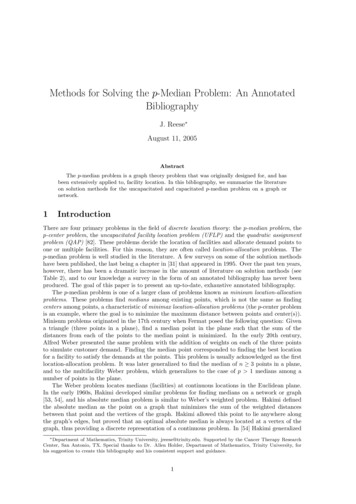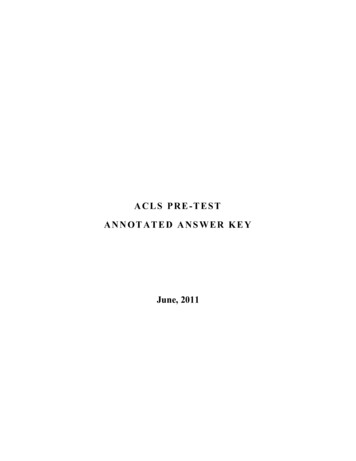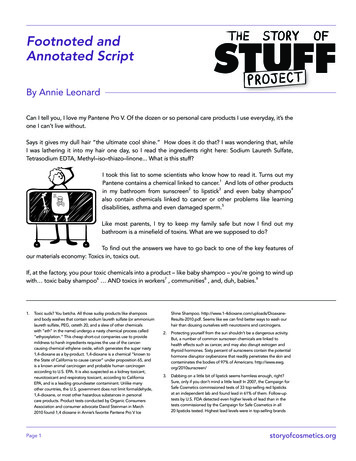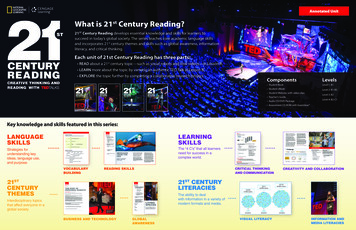
Transcription
Annotated UnitWhat is 21st Century Reading?21ST Century Reading develops essential knowledge and skills for learners tosucceed in today’s global society. The series teaches core academic language skillsand incorporates 21st century themes and skills such as global awareness, informationliteracy, and critical thinking.CENTURYREADINGEach unit of 21st Century Reading has three parts: READ about a 21st century topic—such as social robots and viral videos—in Lesson A. LEARN more about the topic by viewing an authentic TED Talk in Lesson B. EXPLORE the topic further by completing a collaborative research project.CREATIVE THINKING ANDREADING WITHComponentsLevels Student BookLevel 1: B1 Student eBookLevel 2: B1-B2 Student Website, with video clips Teacher’s Guide Audio CD/DVD PackageLevel 3: B2Level 4: B2-C1 Assessment CD-ROM with ExamView Key knowledge and skills featured in this series:LANGUAGESKILLSLEARNINGSKILLSStrategies forunderstanding keyideas, language use,and purpose.The “4 C’s” that all learnersneed for success in acomplex world.VOCABULARYBUILDINGCRITICAL THINKINGAND COMMUNICATIONREADING SKILLS21STCENTURYTHEMESCREATIVITY AND COLLABORATION21ST CENTURYLITERACIESThe ability to dealwith information in a variety ofmodern formats and media.Interdisciplinary topicsthat affect everyone in aglobal societyBUSINESS AND TECHNOLOGYGLOBALAWARENESSVISUAL LITERACYINFORMATION ANDMEDIA LITERACIES
Key knowledge and skills featured in this series:21ST Century ReadingSTUDENT BOOK 1L A N G UAG E S K I L L S 21STCENTURY THEMES LEARNING SKILLS 21 S T C E N T U R Y L I T E R AC I E SUnit 7: Roads to FameLesson A: Going Viral121st Century themes andtopics relevant to learnersin academic education, andthat cover broader issues insociety which affect us all.2321 S T C E N T U R YTHEMESClear Goals make learnersand teachers aware ofthe language and skillobjectives for that unit.Think and Discussa) provides warm upquestions on the themeof the unit, b) allowslearners to share personalexperiences and opinionswith their classmates, andc) allows the teacher to seewhat learners already know.Unit 71ROADSTO FAMEGOALS2Singer David Bowie performsat a concert in Chile. Bowie’ssong “Fame” describes theproblems of being famous.3IN THIS UNIT, YOU WILL:THINK AND DISCUSS Read about an online video thatwent viral. Learn about why certain videosbecome world famous. Explore other videos that went viral.1. Would you like to be famous? Whyor why not?2. Do you think it’s easier to become famoustoday than in the past? Why or why not?92Pagesare reproduced here at 70% of actual size565490 U07 92-105.indd 929310/1/14 11:38 PM565490 U07 92-105.indd 9310/1/14 11:38 PM2
Key knowledge and skills featured in this series:21ST Century ReadingSTUDENT BOOK 1L A N G UAG E S K I L L S 21STCENTURY THEMES LEARNING SKILLS 21 S T C E N T U R Y L I T E R AC I E SUnit 7: Roads to FameLesson A: Going Viral1Lesson A is the mainreading for the unit, anddevelops the learner’sability to understand andrespond to information inwritten English, throughadapted reading passages,infographics, and images.Readings are taken from arange of sources includingNational Geographicand TED.2Lesson A1PRE-READING24An audio recording ofeach reading passage isavailable for learners andteachers, on the Audioprogram, eBook, andStudent Companion Site.A. What kinds of videos become popularon the Internet? Have you ever sharedvideos online? Note your ideas andshare with a partner.5Reading passages getlonger from level to level,starting at 250–330 wordsin level one, and 800–1000words by level 4.3B.Look at the opening quote from AndyWarhol on page 95. What do you thinkhe means? Is his statement becomingtrue? Share your ideas with a partner.C.Look at the title, headings, and graphon pages 95–96. What do you think thereading is about? Choose the bestanswer(s) to complete the statement.L A N G UAG ESKILLSPre-reading prepareslearners to tackle thereading passage bydeveloping and practicingspecific skills, such asskimming, previewing,and predicting.4This passage is about.a. how famous musicians sell theirmusic onlineb. how the quality of videos online isgetting worse3c. how a young singer became famousonline very quickly3Over 6 billion hours of video arewatched each month onYouTube—that's almost an hourfor every person on Earth.The topic of the reading alsoprovides the context forthe TED Talk in Lesson B.For instance, the problem,situation or challenge thatthe speaker addresses intheir talk.GOINGVIRAL4594Pagesare reproduced here at 70% of actual size565490 U07 92-105.indd 94In 1968 the artist Andy Warholpredicted, “In the future, everybodywill be world-famous for 15 minutes.”Today, it seems his prediction isbecoming true.1The tune is simple, and the lyrics don’t makesense. But in 2011, 13-year-old RebeccaBlack’s song “Friday” became a sensation.Black recorded the song as a music video fora small record company. The company postedit on YouTube. In its first month online, very fewpeople saw it. Then a popular blogger wroteabout the video. He called “Friday” the worstvideo ever made.9510/1/14 11:38 PM565490 U07 92-105.indd 9510/1/14 11:38 PM3
Key knowledge and skills featured in this series:21ST Century ReadingSTUDENT BOOK 1L A N G UAG E S K I L L S 21STCENTURY THEMES LEARNING SKILLS 21 S T C E N T U R Y L I T E R AC I E SUnit 7: Roads to FameLesson A: Going Viral1Words or phrases in boldare target words whichare recycled and practicedsystematically in the readingand practice activities.1200 MILLION VIEWS222As much as possible, theAcademic Word List (AWL)has been used to selectthe target vocabularyin each reading. In somecases, useful academicwords in the passage do notcome from the AWL, butare nonetheless importantfor learners to understandand uses.4INSTANT FAME3In the 21st century, our definition of fame haschanged. Online video-sharing sites likeYouTube make it possible for ordinarypeople—instead of movie companies ormagazines, for example—to decide who isGETTING THE MAIN IDEASUse information from the passage on pages 95–96 to answer each question.1.What is the main idea of the passage? Choose the best answer.a. People can make their own music videos and put them on the Internet.b. Anyone has a chance to be famous today.Realistically, though, your chances ofbecoming famous are still fairly small. In fact,90 percent of videos viewed on YouTube areof people, like pop stars, who are alreadyfamous.tune: n. the melody or music of a songc. Becoming famous is harder now because there is so much competition.2.Why did Black’s video suddenly become popular?a. People realized it was a good video to watch on Friday.3b. People heard that the video was bad and wanted to see it.c. People liked Rebecca Black’s other videos.lyrics: n. the words of a song3.According to the reading passage, how has fame changed in the 21st century?SCANNING FOR NUMBERS4Number of Views600,000500,0001. Andy Warhol predicted everyone would befamous for 50 minutes.3. By the end of 2011, Black’s video hadalmost 200,000 views.2. Rebecca Black was 13 years old whenshe made the video “Friday.”4. Ninety percent of videos viewed on YouTubeare of people who are already stars.At the back of eachStudent Book, aVocabulary Logallows learners torecord definitions andexamples of targetvocabulary for eachunit. Word indicatedwith an asterisk arefrom the AcademicWord List.UNDERSTANDING A GRAPHA. Look again at the graph on page 96. Based on the reading, what are the dates400,000when the following events happened?300,0001. “Friday” first posted on YouTube.200,0002. Blogger writes that “Friday” is the worst video ever.100,0003. Over 600,000 views of “Friday” on one day.21 S T C E N T U R YL I T E R AC I E SInfographics are helplearners develop the abilityto deal with informationin a variety of non-textualformats, and include graphs,charts, maps, timelines,and diagrams.L A N G UAG ESKILLSWhat information did the passage on pages 95–96 include? Write T for True or F for False foreach statement. If the statement is false, correct it.700,000Unfamiliar words whichfall outside the targetvocabulary are glossed asfootnotes under the readingpassage.Developing ReadingSkills provides postreading tasks to drawlearners’ attention to themain idea of the passage,the key supportingarguments, practice withthe target vocabulary, andcritical thinking.Developing Reading SkillsViews per day of “Friday”video by Rebecca Black34Suddenly, the video went viral. Everyonewanted to see if “Friday” was really so bad.People often watched the video on Friday.Soon, other people posted similar musicvideos, inspired by “Friday.” For example, afamous comedian posted a video called“Thursday.” It had the same tune but differentwords. Its lyrics didn’t make sense either, butthey were very funny. By the end of 2011,“Friday” had over 200 million views. It was oneof the most-watched videos on YouTube. Blackwas famous.55famous. We all now have more ownership ofour own pop culture, and no-one has togreen-light our ideas—you can upload yourown videos or publish your own work at anytime. However, this fame may not be based onany actual talent. You could be famous forbeing a very bad singer or just doingsomething ridiculous. For some people, thiscan mean that fame happens when we don’texpect it or even when we don’t want it.B. How many weeks did it take for “Friday” to go from almost no views per day to2/22/11 2/25/113/4/113/11/113/18/11Date3/25/114/1/11over 600,000 views per day?4/8/11Source: YouTube96Pagesare reproduced here at 70% of actual size565490 U07 92-105.indd 969710/1/14 11:38 PM565490 U07 92-105.indd 9710/1/14 11:38 PM4
Key knowledge and skills featured in this series:21ST Century ReadingSTUDENT BOOK 1L A N G UAG E S K I L L S 21STCENTURY THEMES LEARNING SKILLS 21 S T C E N T U R Y L I T E R AC I E SUnit 7: Roads to FameLesson A: Going Viral12Developing Reading SkillsBuilding Vocabularyprovides practice to ensurelearners understand and canuse the target vocabularycorrectly.IDENTIFYING TRANSITION WORDSparagraph with the words below.expectedA. Find and underline the following sentences in the passage on pages 95–96.2012. Hesensationsuddenlythe song to be a hit in Korea, but thevideo for the song also became a worldwide.While popular in his own country, Psy was not well known inB. Write and or but to complete the sentences.1. Many people become famous on the Internet,3. The video went viral,posted“Gangnam Style,” by Korean star Psy, was released in July1. A sentence that connects ideas using and. (Paragraph 1)2. Two sentences that connect ideas using but. (Paragraph 2)3. A sentence that connects ideas using and. (Paragraph 3)2. A small record company made the videothe rest of the world. But a week after releasing the video forthe fame doesn’t usually last.the song, a famous rapper tweeted about how great the videoposted it on YouTube.was.people started to post videos like it., many other famous people3messages about the video. Millions of people read theGETTING MEANING FROM CONTEXTmessages and went to view the video on YouTube. WithinA. The writer explains how Rebecca Black’s video “went viral.”How would you define “went viral”?days, “Gangnam Style” went viral. Today, the video has beenwatched over 2 billion times.2B. The writer says that today, no one has to “green-light” your ideas. What does“green-light” mean? What’s another way of expressing the same idea?1Critical Thinking helpslearners develop skillswhich give them a deeperunderstanding of thereading, and includeanalyzing reasons,evaluating the writer’sclaims, reflecting onand applying their ownexperience to the passage,and others.B. Read about another video that went viral. Complete theWriters use transition words when they want to connect (and) or contrast (but) two ideas. Identifyingtransition words lets you connect ideas as you read.LEARNINGSKILLSBUILDING VOCABULARYIn 2012, Psy’s “Gangnam Style”became the first music videoto exceed one billion views onYouTube.Explore More directs thelearner to further readingor viewing, at related TEDor National Geographicsources. This encouragesthem to go beyond the textto authentic sources.CRITICAL THINKING1.Inferring. Do you think Black liked her instant fame? Why or why not?2.Personalizing. Which people in your country can influence whether someonebecomes famous?A. Complete each sentence with the correct form of the bold word or expression fromthe passage on pages 95–96.1. When something2.3. A4. To, it is easy to understand.3is a special ability that lets you do something well.EXPLORE MOREFind and watch Rebecca Black’s “Friday” video on YouTube.com. What do you think of thevideo? Do you agree with the blogger that it’s the worst video ever?is the meaning of a word or an idea.something is to say that it will happen in the future.98Pagesare reproduced here at 70% of actual size565490 U07 92-105.indd 989910/1/14 11:38 PM565490 U07 92-105.indd 9910/1/14 11:38 PM5
Key knowledge and skills featured in this series:21ST Century ReadingSTUDENT BOOK 1L A N G UAG E S K I L L S 21STCENTURY THEMES LEARNING SKILLS 21 S T C E N T U R Y L I T E R AC I E SUnit 7: Roads to FameLesson B: Why Videos Go Viral1Build around an edited TEDTalk video clip, Lesson Bfocuses on that talk’slanguage and key ideas.The lesson provides a seriesof tasks and activities whichprovide learners with thechance to develop 21stcentury skills. The focus is onthe “4 C’s”: Critical thinking,Communication, Creativity,and Collaboration.2A short opening textintroduces the TED Talk.It provides context forthe video, with shortcomprehension and/ordiscussion questions.Lesson BThe TED Talk chosen buildsupon the topic andlanguage of Lesson A,helping learners becomemore comfortableusing them.21 S T C E N T U R YTHEMESTED speakers are allexperts in their field, andhave been selected by TEDas the best person to speakon the topic covered.1WHY VIDEOS GOVIRALKEVIN ALLOCCA YouTube Trends Manager, TED speakerAllocca’s job is to watch videos. But he doesn’t just watch them for pleasure. He paysattention to videos that are becoming very popular, or “going viral.” In 2014, YouTubehad more than 1 billion users a month. And those users uploaded dozens of hours ofvideo every minute. Only a small percentage of these videos actually becomeInternet sensations.24It is hard to predict which videos will go viral, but Allocca has interesting ideas aboutwhy some videos are more popular than others.user: n. a person who uses a product or serviceIn this lesson, you are going to watch Allocca’s TED Talk from 2011. Use the informationabove to answer the questions.1.34LEARNINGSKILLSKevin Allocca’s idea worthspreading is that the future ofentertainment is one where everyonefeels ownership over pop culture andcan play a role in shaping both thecontent and its popularity.3What does Kevin Allocca do in his job?2. How many users visited YouTube every month in 2014?3. Is it easy to predict which videos will go viral? What ideas do you think Allocca has?100Pagesare reproduced here at 70% of actual size565490 U07 92-105.indd 10010110/1/14 11:38 PM565490 U07 92-105.indd 10110/1/14 11:38 PM6
Key knowledge and skills featured in this series:21ST Century ReadingSTUDENT BOOK 1L A N G UAG E S K I L L S 21STCENTURY THEMES LEARNING SKILLS 21 S T C E N T U R Y L I T E R AC I E SUnit 7: Roads to FameLesson B: Why Videos Go Viral1L A N G UAG ESKILLSThe main part of LessonB is a series of tasks thatfocus on a) Understandingthe speaker’s main idea andmessage, b) Identifying theideas and key points in thetalk, and c) Studying thespeaker’s use of languageGETTING THE MAIN IDEASSinger Elvis Presley surroundedby fans, 1956.2A. Watch () the first part of Kevin Allocca’s TED Talk. What is the purpose of thissegment of Allocca’s TED Talk? Choose the two best statements.a. To introduce his ideas about why videos go viralb. To show how some videos make us feel sadc. To explain how a tastemaker can influence others2B. How did Bear Vasquez video go viral? Check (Adapted and edited TEDTalk video clips areintegrated into Lesson B,with the complete videotranscript available at theback of the Student Book.1. Vasquez posted his video on YouTube.4. Kimmel put the video on his website.2. Vasquez told his friends about the video.5. Millions of people watchedVasquez video.3. Jimmy Kimmel, a tastemaker, tweetedabout the video.PART 221 S T C E N T U R YL I T E R AC I E SPARTICIPATIONPREVIEWINGPART 13) the three steps that Alloccamentions in his talk.WhythinkVideosA. Read the excerpt from the next segment of Allocca’s TED Talk. What do youGo ViralTASTEMAKERS 1the missing words are?Part 1PREVIEWINGBut what’s important here is thecelebrities, singers,when I wasityounger,this techie, geeky Internet culture. A n entire remix community sproutedupcomedians—andthat broughtthat seemed so very, very hard to do. But now Web video haswhen he says that viral videos become a “cultural moment”?from being just a stupidtechie: adj. very interested in technologygeeky: adj. of a person who is very interested ina particular hobby, especially computers3tastemaker: n. a person who introduces other people to things that are fashionableB. Read the excerpt again. Circle the three things that make a video go viral.B.made it so that any of us or any of the creative things that wedo can become completely famous in a part of our world’sculture. Any one of you could be famous on the Internet bynext Saturday. But there are over 48 hours of video uploadedto YouTube every minute. And of that, only a tiny percentageever goes viral and gets tons of views and becomes a culturalmoment. So how does it happen? Three things: tastemakers,communities of participation, and unexpectedness. All right,let’s go.to something that we can all actually be a part of .Because we don’t just enjoy now, weAny one of you could be famous on the Internet by next Saturday. But there are over48 hours of video uploaded to YouTube every minute. And of that, only a tiny percentageever goes viral and gets tons of views and becomes a cultural moment. So how does ithappen? Three things: tastemakers, communities of participation, and unexpectedness.[Video] Bear Vasquez: Oh, my God. Oh, my God. Oh, myGod! Wooo! Ohhhhh, wowwww!sprouted up: v. grew upLast year, Bear Vasquez posted this video that he had shotoutside his home in Yosemite National Park. In 2010, it wasviewed 23 million times. This is a chart of what it lookedlike when it first became popular last summer. But he didn’tactually set out to make a viral video, Bear . . .And this video had actually been posted all the way back inJanuary. So what happened here? Jimmy Kimmel, actually.Now watch ( ) the next segment of Allocca’s TED Talk, andJimmycheckKimmel yourposted thisanswers.tweet that would eventually propelthe video to be as popular as it would become. BecauseAccording to Allocca, which video inspired people to immel introduceus to new andinteresting things and bring them to a larger audience.What do these three things mean, and how do you think they help videos go viral?Discuss with a partner.a. “Friday”b. “Nyan Cat”102Pagesare reproduced here at 70% of actual size565490 U07 92-105.indd 102I’m Kevin Allocca. I’m the trends manager at YouTube,that [the videoHi.clip]inspired amongstand I professionally watch YouTube videos. It’s true. Sowe’re going to talk a little bit today about how videos go viraland then why that even matters. We all want to be stars—A. Scan the excerpt below from Allocca’s TED Talk. What do you think Allocca meansEdited TED Talk video clipsare divided into parts tomake it easier for the learnerto work with the material.Unit 7KEVIN ALLOCCA10/1/14 11:38 PM565490 U07 92-105.indd 103Part 2[Video] Rebecca Black: It’s Friday, Friday. Gotta get downon Friday. Everybody’s looking forward to the weekend,weekend. Friday, Friday. Gettin’ down on Friday.So you didn’t think that we could actually have thisconversation without talking about this video, I hope. RebeccaBlack‘s “Friday” is one of the most popular videos of the year.It’s been seen nearly 200 million times this year. This is achart of what it looked like. And similar to “Double Rainbow,” itseems to have just sprouted up out of nowhere.So what happened on this day? Well, it was a Friday, this istrue. And if you’re wondering about those other spikes, thoseare also Fridays. But what about this day, this one particularFriday? Well, Tosh.0 picked it up, a lot of blogs starting writingabout it. Michael J. Nelson from Mystery Science Theaterwas one of the first people to post a joke about the video onTwitter. But what’s important is that an individual or a group oftastemakers took a point of view and they shared that with alarger audience, accelerating the process.And so then this community formed of people who sharedthis big inside joke and they started talking about it anddoing things with it. And now there are 10,000 parodiesof “Friday” on YouTube. Even in the first seven days, therewas one parody for every other day of the week. Unlike theone-way entertainment of the 20th century, this communityparticipation is how we become a part of the phenomenon—either by spreading it or by doing something new with it.TED TALK VIDEO CLIPS[Music] So “Nyan Cat” is a looped animation with loopedmusic. It’s this, just like this. It’s been viewed nearly 50 milliontimes this year. And if you think that that is weird, you shouldknow that there is a three-hour version of this that’s beenviewed four million times. Even cats were watching this video.Cats were watching other cats watch this video. One video clip per unitBut what’s important here is the creativity that it inspiredamongst this techie, geeky Internet culture. There wereremixes. Someone made an old-timey version. And then itwent international. An entire remix community sprouted upthat brought it from being just a stupid joke to something thatwe can all actually be a part of. Because we don’t just enjoynow, we participate. Video clips use authenticlanguage, but have beenedited down to 3–6minutes (original TED Talksare 18 minutes long)Part 3And who could have predicted any of this? Who could havepredicted “Double Rainbow” or Rebecca Black or “NyanCat”? What scripts could you have written that would havecontained this in it? In a world where over two days of videoget uploaded every minute, only that which is truly uniqueand unexpected can stand out in the way that these thingshave. When a friend of mine told me that I needed to see thisgreat video about a guy protesting bicycle fines in New YorkCity, I admit I wasn’t very interested. Video clips are availableon the:-- Classroom DVD-- Student eBook-- Instructor eBook[Video] Casey Niestat: So I got a ticket for not riding in thebike lane, but often there are obstructions that keep you fromproperly riding in the bike lane.By being totally surprising and humorous, Casey Niestat gothis funny idea and point seen 5 million times. And so thisapproach holds for anything new that we do creatively. And soit all brings us to one big question .103[Video] Bear Vasquez: What does this mean? Ohhhh.What does it mean? Tastemakers, creative participatingcommunities, complete unexpectedness, these arecharacteristics of a new kind of media and a new kind ofculture where anyone has access, and the audience definesthe popularity. . . . Video transcripts areavailable at the back of theStudent BookThis is an edited version10/1/14of Allocca’s11:382011 TEDPMTalk. To watch the full talk visit TED.com.154565490 VS 148-157.indd 15410/1/14 11:43 PM7
Key knowledge and skills featured in this series:21ST Century ReadingSTUDENT BOOK 1L A N G UAG E S K I L L S 21STCENTURY THEMES LEARNING SKILLS 21 S T C E N T U R Y L I T E R AC I E SUnit 7: Roads to FameLesson B: Why Videos Go Viral1321 S T C E N T U R YL I T E R AC I E SAt least one task includes agraphic organizer to showlearners how to summarizethe main idea or explain therelationships between keypoints in the talk.Each unit ends with acollaborative Project, inwhich learners use thelanguage and content fromthe whole unit to respondto a task related to the topic.ProjectRECOGNIZING THE SPEAKER’S MESSAGEComplete the sentence using Allocca’s ideas from this segment of his talk.People don’t just sit and watch a video, they alsoLEARNINGSKILLS.PART 3UNEXPECTEDNESS24UNDERSTANDING KEY DETAILSLEARNINGSKILLSThroughout the learneris encouraged to thinkcritically about the speaker,their message, and howtheir own opinions aboutthe talk and its content.Read the sentences. Then watch ( ) this segment of Kevin Allocca’s TED Talk.Check ( ) the ones that reflect what he says.1. Videos that are surprising are likely to go viral.3. It was easy to predict Casey Niestadt’s videowould go viral.2. Unique and unexpected videos stand out more.4. The audience now decides the popularity ofa video.A. Complete the graphic organizer with the information you learned from Allocca’sTED Talk.How videosgo viral1Influence oftastemakersA. You are going to research a video thatwent viral.3Nyan Cat1. Work with a partner. Choose a video thatyou know that went viral. Or use one of thevideos below. David Blaine, How I held my breath for17 minutes (TED.com) 7 Billion (video.nationalgeographic.com) Eric Whitacre, A virtual choir (TED.com)B. What other factors can help make a video go viral? Discuss your ideas with a partner.CRITICAL THINKINGLearners work together ingroups to solve a problem;research, take notes andpresent; or create a writtenresponse of some kind.An image taken from Eric Whitacre’s YouTube video,Virtual Choir 2.0, which went viral in 2011. In the video,Whitacre conducts over 2,000 voices from 58 countries.USING VISUALS TO SUMMARIZELEARNINGSKILLS2. Watch the video and ask yourselvesthese questions:2 What is unexpected about the video? Why do you think the video went viral?Applying. Allocca says, “[W]e don’t just enjoy now, we participate.” What are some other wayspeople participate online? Discuss with a partner.3. Make a list of ways that people could“participate” with this video. Think about KevinAllocca’s ideas from his TED Talk.B. Present your video to your class. Explain whyyou think it went viral.C. As a class, discuss which video you wouldshare with your friends.4EXPLORE MOREFind out what videos are trending now at youtubetrends.blogspot.com. Share what you learned withyour class.EXPLORE MOREView Kevin Allocca’s full TED Talk at TED.com. Which of the YouTube videos would you sharewith your friends? Why?104Pagesare reproduced here at 70% of actual size565490 U07 92-105.indd 10410510/1/14 11:38 PM565490 U07 92-105.indd 10510/1/14 11:38 PM8
and incorporates 21st century themes and skills such as global awareness, information literacy, and critical thinking. Each unit of 21st Century Reading has three parts: READ about a 21st century topic—such as social robots and viral videos—in Lesson A. LEARN more abou
